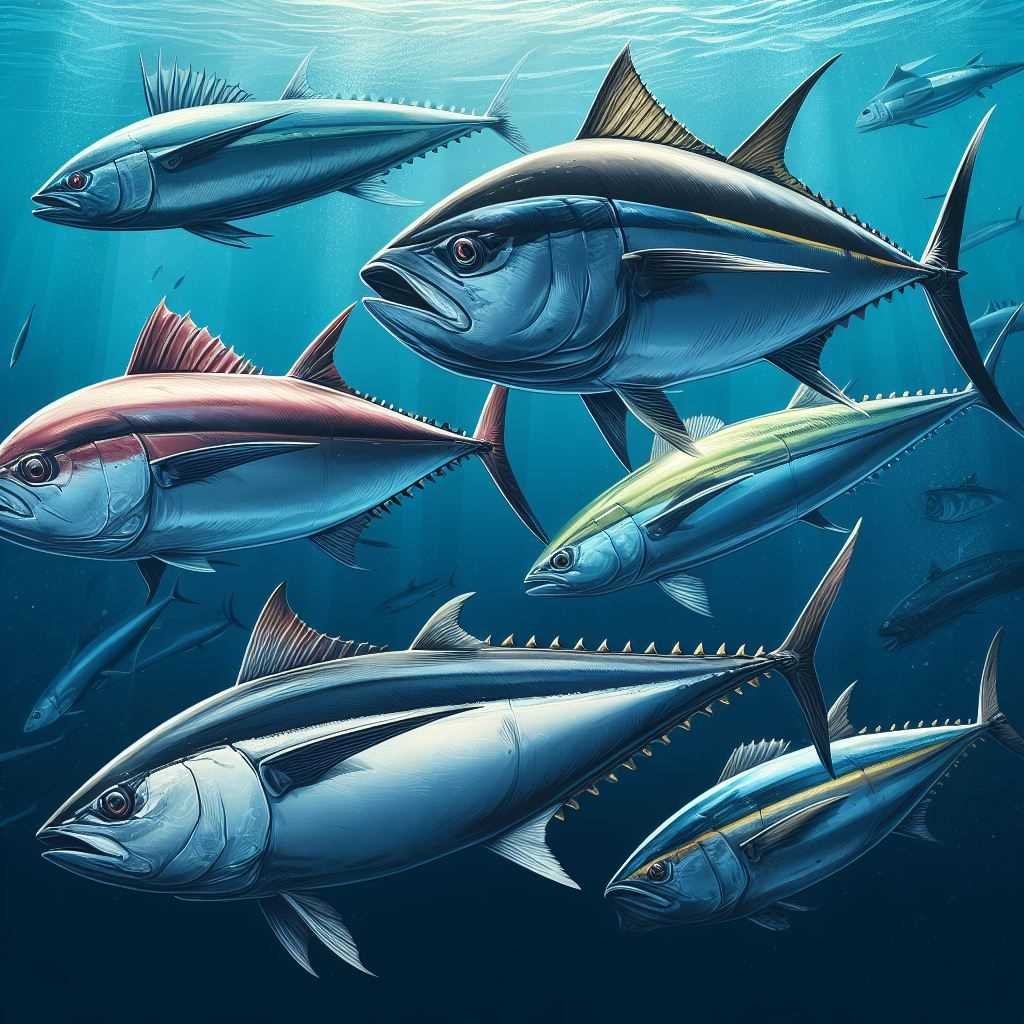Best Tuna Fishing Conditions and Optimal Time to Fish
Tuna are prized game fish that offer anglers around the world an exciting challenge. However, successfully catching these aquatic athletes requires knowledge of tuna behavior, migration patterns, feeding habits and favored environmental conditions. This article delves into the key factors that impact tuna location and activity, providing insights on conditions and times that are optimal for tuna fishing.
Key Takeaways
- Water temperature is critical, with each tuna species favoring a certain range. Follow seasonal changes in water temps.
- Moderate winds of 5-15 knots are optimal. Tuna position based on wind direction and structure.
- Low light at dawn, dusk and night are prime feeding times when tuna are most active.
- Match hatch with baitfish colors and profiles that mimic the type of natural prey present.
- Clear water calls for natural presentations. Turbid water favors loud lures with vibration and flash.
- Patrol structure like ledges, banks, and weedlines where baitfish congregate.
- Be adaptable to changing conditions on any given day for best success. Fish hard during peak windows.
- Plan trips for seasonal windows and locations known for favoring certain tuna species.
- Monitor forecasts closely for optimal weather conditions and prime feeding windows.
- Use the tides to your advantage. Structure holds more fish on a flooding tidal push.
- Employ the right tactics and gear for targeted species. Yellowfin like speed. Bluefin prefer large natural baits.
- Observe tuna behavior each day. Feeding habits change daily based on conditions and available prey.
- When you locate actively feeding tuna, stay with them as long as the bite holds up. Don’t leave fish to find fish.
Water Temperature: A Key Influence on Tuna Presence

Water temperature is one of the most significant factors governing tuna distribution and behavior. Most tuna species thrive in specific temperature ranges and will migrate long distances to remain in suitable waters.
Yellowfin tuna prefer temperatures between 72-82°F, with larger individuals tending to favor slightly cooler waters below 78°F. In contrast, bluefin tuna can tolerate a wider temperature range from 43-81°F but seem to thrive best between 59-68°F. Bigeye tuna occupy waters from 60-80°F.
Understanding these preferred temperature ranges provides anglers guidance on productive areas to target. As seasons change, tuna will follow the progression of warm currents to stay within their optimal thermal habitat. See the Hawaii fishing calendar here.
Wind Speed and Direction: Impacts on Tuna Location

Wind speed and direction strongly influence tuna distribution on a given day. Tuna tend to congregate on the downwind side of islands, points or structures where wind and current interact to aggregate food.
A north or northwest wind in the morning, shifting south in the afternoon, is considered productive for finding tuna on the surface. The initial northerly winds push baitfish and tuna to sheltered south-facing shorelines. When winds shift southerly, tuna are likely to move offshore and north following bait pushed by the wind.
Light breezes between 5-15 knots are favorable, while 20+ knot winds make for challenging fishing and likely push tuna deeper or away from areas churned up by waves. Anglers should monitor marine weather forecasts and note the wind’s speed and direction when planning an outing.
Turbidity and Water Clarity
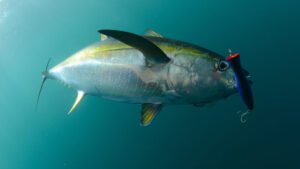
Turbidity refers to the cloudiness or clarity of the water, which significantly impacts tuna distribution and behavior. Tuna rely heavily on vision when hunting, so water clarity is a key factor.
Tuna tend to prefer clearer blue water where visibility exceeds 30 feet. However, some turbidity can concentrate food. Tuna gather below mudlines, current rips, temperature breaks and eddies where plankton and baitfish accumulate. In turbulent water, using sounders helps locate promising below-surface structure.
In clear water, trolling natural bait near weedlines, kelp paddies, floating debris or over rocky bottom structure can be effective. In turbid water, target areas of mixing water indicated by color/temperature changes.
Using Light Levels to Your Advantage
In general, low light conditions early and late in the day are more productive for catching tuna. Many species exhibit crepuscular behavior, meaning they are more actively feeding during these twilight periods.
Morning hours often yield the highest tuna activity. Productive times are from daybreak through mid-morning. Late afternoons can also be worthwhile, especially on cloudy days, as tuna sense the impending nightfall.
On sunny days, tuna often descend deeper around mid-day when surface waters warm and light penetrates deeper. During these bright hours, trolling deep-diving plugs, downriggers or target fish holding near structure with jigs or live bait. Night fishing under lights can also be productive in some locations.
Prime Fishing Tactics Based on Prey
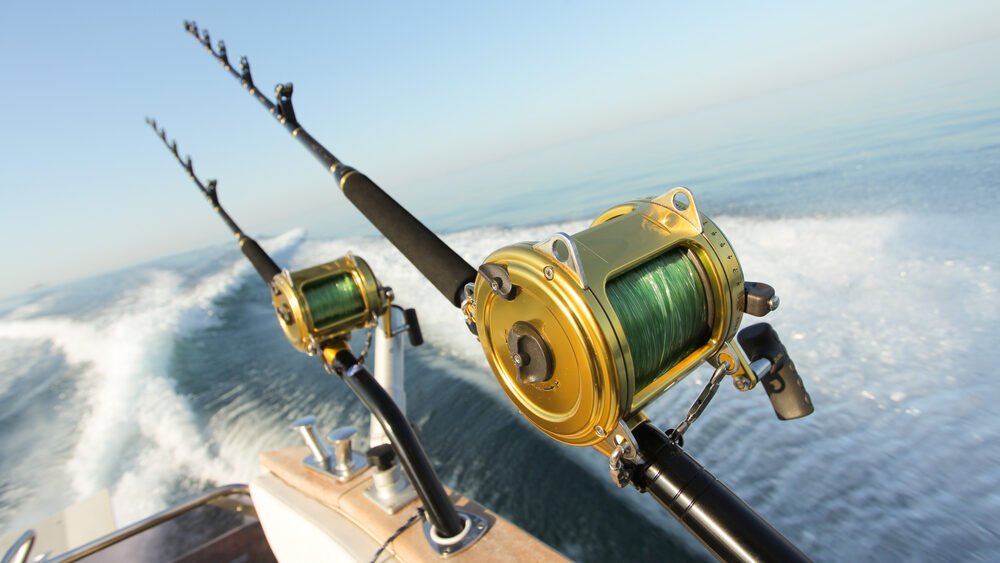
Tuna are constantly on the search for food and orient their movements based on baitfish location. Experienced tuna anglers choose lures and tactics that match the type of forage present.
Trolling natural bait – Like sardines, mackerel, squid or small tuna near breaks, ledges and weedlines is a proven technique when these baits are present. Target areas hold large concentrations of these baitfish.
Imitating flying fish – When tuna are keyed in on flying fish, trolling bird-like artificials that mimic their erratic movements gets results. Magnum sized poppers skipped aggressively across the surface are also effective.
Matching hatch with flies – When tuna are gorging on tiny organisms like krill, a properly sized fly fished on a straight floating or clear intermediate line can be the perfect imitation. retrieving slowly allows the fly to mimic the natural prey’s movements.
Jigging – If squid or small silver baitfish are abundant, jigging can be deadly. Shimmying leadhead jigs or castable rubber shads up and down in the water column drives tuna wild. Adding a rubber shad or real squid strip sweetens the offering.
Prime Locations Based on Species and Season

While tuna roam immense distances in the open ocean, there are recognized productive fisheries throughout their range. Certain areas consistently produce good fishing during defined seasons.
Yellowfin – Cabo San Lucas sees consistent yellowfin tuna action virtually year-round. The abundant baitfish and nutrient-rich currents create prime habitat. During the warmer months, the southern California coastline also sees large numbers of yellowfin tuna.
Bluefin – Cape Cod is legendary for its bluefin tuna fishery from June through October when they migrate north into New England waters. Winter fishing off North Carolina has also gained popularity for giant bluefin tuna.
Bigeye – Hawaii sees outstanding bigeye tuna fishing from spring through fall when they congregate around offshore seamounts and buoys. The abundant baitfish draw in these larger tuna.
Albacore – The Pacific Northwest witnesses seasonal albacore migrations from June through September. Trolling leads to plenty of longfin action during these warmer months offshore.
Optimal Techniques Based on Seasonal Location

As tuna migrate and follow preferred water conditions, the most effective techniques and gear change. Adapting strategies based on location maximizes the chances of connecting with tuna.
Northern Waters – In northern waters like New England, colder temperatures call for trolling with whole natural baits like mackerel or herring. Heavier gear in the 50-80 pound class handles powerful fish around structure.
Southern Waters – Around Baja, Cabo and southern California, the warmer waters call for higher-speed trolling with skirted lures, cedar plugs and umbrella rigs. Lighter 30-50 pound tackle allows covering more ground to find fish.
Open Ocean – Targeting tuna offshore in the Pacific and Atlantic mid-latitude waters requires scanning immense areas. Trolling spreads of islander/jethead lures covers ground to pinpoint nomadic fish. Once located, live bait fishing keeps them close.
Inshore Locales – Around islands and oil rigs in southern waters, fly fishing and casting poppers, stickbaits and jigs to surface-feeding tuna can provide explosive action on lighter spin or conventional tackle.
Prime Times Based on Season and Conditions
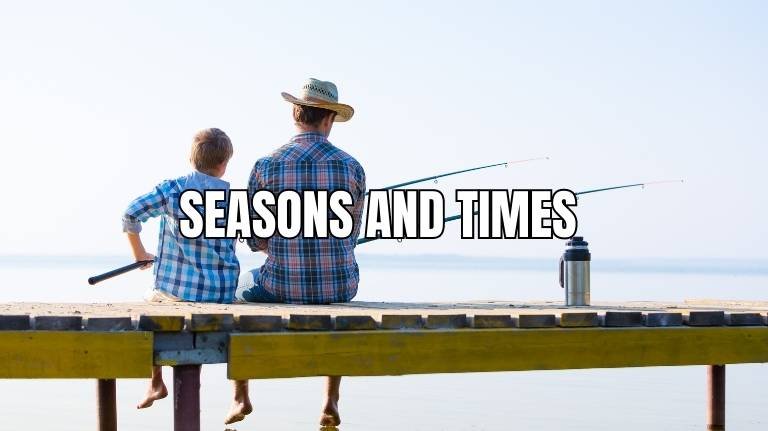
While tuna might be caught during any part of the day, key patterns emerge for peak feeding activity.
Warmer Months
During summer, mornings and evenings are best. The low-angle light allows anglers to spot breaking fish, birds working bait, and other key signs of feeding tuna. Afternoons tend to see less surface action during the heat.
Colder Months
When water temps drop in fall and winter, the warming effects of the sun penetration help get tuna active. Mid-day is prime time to capitalize on these solar conditions.
During Fronts
Barometric pressure shifts that precede cold fronts or storms seem to spur a frenzied tuna bite before the weather changes. These unstable conditions don’t last long but can result in red-hot action.
Overnight
For night owls, after-dark fishing under lights around offshore rigs and islands can result in explosive pops and bites when tuna and bait gather in the illumination. This tactic works best on warmer nights with little moon.
Key Species-Specific Behaviors
While species like yellowfin, bluefin, bigeye and albacore share some common habits and preferences, each tuna also exhibits unique behaviors that require tailored fishing strategies.
Yellowfin

Yellowfin tuna are aggressive predators that readily take baits and lures trolled, cast or fished vertically. Pound for pound, the athletic yellowfin offers unmatched aerial displays and fighting prowess on light tackle.
Temperature – Yellowfin prefer warmer water between 72-85°F. They are most abundant in tropical and subtropical waters worldwide. As temperature drops in winter, they migrate toward the equator.
Food – Yellowfin feed voraciously on a wide range of baitfish, crustaceans and squid. Their adaptation to varied prey allows them to thrive in most warm-water habitats.
Behavior – More active and willing biters than bluefin, yellowfin readily chase down fast-moving lures and baits. They frequent well-defined temperature breaks and structure where bait gathers.
Technique – Trolling fast-moving skirted lures, cedar plugs and deep diving planers around structure and temperature gradients is effective for yellowfin ahi fishing.
Bluefin

Bluefin tuna are prized trophies renowned for their power and stubborn fights. More than any species, currents and water temperatures govern their migrations and distribution.
Temperature – Bluefin tolerate a wide range of temperatures from 43-81°F but seem to thrive best between 59-68°F. They frequent areas where those preferred temperatures exist based on seasonal movement of currents.
Food – Herring, mackerel, sand lance, squid and krill make up much of the bluefin’s diet. Matching the size of natural baits is key when trolling or chunking for bluefin.
Behavior – Bluefin often travel in large numbers. They move long distances seasonally to stay in their preferred temperature zone, following bait migrations.
Technique – Trolling large swimming plugs like Zuks, Crippled Herrings near areas of structure and temperature breaks where bait schools up is effective for bluefin.
Bigeye

Known for their long-distance migrations, bigeye tuna are prized sportfish due to their tenacious fights and excellent eating. Their extensive travels make pinpointing them challenging.
Temperature – Bigeye occupy a wide thermal range from around 60-80°F but seem to prefer 70-75°F based on available prey species.
Food – Primarily fish eaters, bigeye feed on small tuna, opah, swordfish, and squid attracted to light that draw in bait.
Behavior – covers immense expanses of open ocean, congregating in areas of upwelling and structure. Nocturnal tendencies and unique night vision adaptations.
Technique – Drifting chunks of squid and fish belly, trolling cedar plugs and skirted lures are all effective, especially at night when bigeyes are most active.
Albacore

The longfin tuna offers exceptional light tackle sport on their seasonal migrations along the Pacific coastline. Their large numbers provide consistent action when you find them.
Temperature – Albacore prefer cooler water between 55-65°F due to their metabolisms adapted for colder northern regions.
Food – Small baitfish like anchovies, sardines, and squid are primary prey. They mainly target migratory fishes moving seasonally to feed.
Behavior – Schools massively along thermal gradients and structure during warm months. Fast moving and readily strike artificial lures retrieved to mimic fleeing baitfish.
Technique – Trolling small, brightly colored feather/plastic squid combinations at varying depths is an effective way to find and catch albacore during their seasonal movements.
Prime Feeding Habits Based on Time of Day
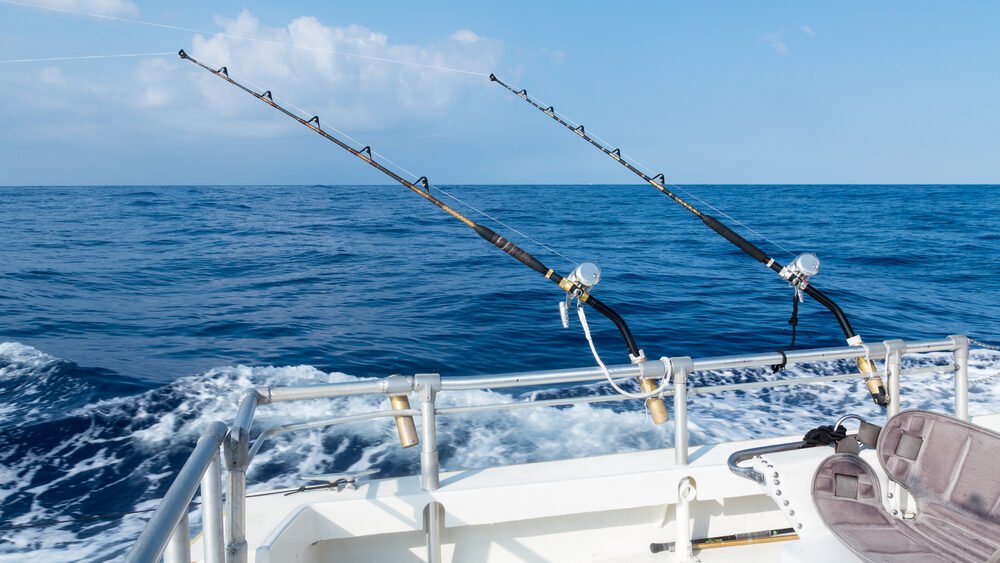
Tunas’ daily feeding habits change, with optimal times to catch them feeding on the surface or deeper during low light periods when they hunt most actively.
Dawn and Dusk
Low light conditions at dawn and dusk turn tuna on, making these optimal times for catching them on the prowl. The shadows and reduced glare improve their vision while vulnerable baitfish are also more active. Early morning often sees the most ravenous bite that tapers off into late morning. Feeding activity picks up again in the afternoon as the setting sun signals another prime window.
Targeting structure and current seams that congregate baitfish is key during low light hours. Trolled diving plugs, surface poppers, and live baits presented around these areas draw savage strikes. Dawn and dusk feeding frenzies often provide the most consistent action.
Mid-Day
Once the sun climbs high in the sky, tuna often descend into deeper, darker depths where they remain active hunters. While surface action may wane, the fish continue to cruise and attack prey suspended in the water column.
This mid-day period calls for trolling deep diving plugs, bomb-style planers, and live baits fished beneath the surface up to 150 feet down. Lures mimicking squid, or real dead or live squid are also effective. Switching to tactics that dive below the sunny surface layers keeps hookups coming.
Night
For those willing to burn the midnight oil, fishing after dark can be extremely productive. Many tuna species exhibit crepuscular tendencies, feeding extensively when light levels are low. Full moons can make the night bite more challenging, while darker new moon periods see the best action.
Areas around lighted oil platforms, rigs, and channel buoys attract huge schools of baitfish that draw in tuna. Bait or lures fished under hanging lights, or trolled divers and plugs in surrounding black waters can lead to explosive jolts. Bigeye tuna are notably nocturnal and more active after sundown. Their unique binocular vision is adapted for low light predation.
Weather Conditions and Water Clarity

Along with temperatures and light levels, water conditions and weather also impact when and where tuna congregate. Paying close attention to forecasts helps predict promising fishing windows.
Optimal Weather
Tuna are remarkably resilient fish that feed in most conditions from dead calm to blustery. However, more moderate winds between 5-15 knots often bring the best overall fishing conditions. This allows covering water to locate fish without excessively churned seas.
Passing storms and cold fronts might disrupt the bite for short periods as barometric pressure shifts. However, the hours right before a front often see flurries of intense tuna activity. Savvy anglers watch forecasts and take advantage of these brief, but often epic windows.
Extremely hot, sunny conditions can also make mid-day surface fishing tougher. Seeking out shade lines and rip lines with breaks in clear water are key to finding active mid-day biters.
Wind Direction
Paying attention to not just wind speeds but also wind direction is critical. As discussed previously, tuna will orient to the leeward sides of points, islands, and ledges depending on wind direction.
Morning off-shore breezes push them toward sheltered shorelines. When afternoon winds shift directions, tuna will move back out to sea or to the freshly-leeward side of structure. Noting wind direction – even if it changes – keeps you in position to intercept moving schools.
Water Clarity
Clarity and turbidity greatly affect the way tuna hunt and anglers should adapt accordingly. Clear blue water calls for matching the hatch with natural baits or precisely imitating specific forage like flying fish or squid. TiClarity reduces effectiveness of artificial lures, putting emphasis on liveliness of presentations.
In contrast, stained or muddy water calls for vibration, flash and motion to draw strikes. Solid colors, rattles, metallic finishes and noisy popping plugs help make up for the low visibility. Reactance to these visual and auditory stimulants makes up for blurred vision in turbid surroundings.
Best Fishing Methods Based on Prey & Structure

Tuning into the specific baitfish present and adjusting tactics accordingly is one of the biggest keys to tuna success. Their prey preferences change based on habitat and conditions. Matching your offerings to the present forage is critical.
Trolling Natural Baits
Trolling small tuna, mackerel, herring or other oily baitfish on wire line, planers or downriggers remains one of the deadliest techniques for all tuna species. The oily scent trails and lifelike swimming action are irresistible when tuna are keyed into these natural prey items.
Targeting structure like ledges, weedlines and pinnacles that congregate these baitfish with deep-swimming presentations is extremely effective. Allowing baits to wander from structures into the open water is also a great tactic that triggers reaction strikes.
Casting Poppers & Stick Baits
When tuna pinball wildly across the surface attacking terrified baitfish, flashy stickbaits like Bombers, Yo-Zuris and Redfin Shads cast right into the frenzy draw savage strikes. Aerodynamic poppers skipped across the surface send out vibrations that mimic wounded baitfish and tempt explosive hits.
Schools of busting tuna can’t resist these lively imitations of the fleeing bait they are targeting. Retrieved erratically with jerks and cranks, they perfectly mimic the evasive maneuvers of distressed baitfish that drive tuna into a feeding fury.
Vertical Jigging
Jigging has become a lethal technique for tuna around structures worldwide. The juddering action of weighted jigs worked vertically incites instinctual strikes from tuna even when they aren’t visibly surface feeding. Adding assist hooks and sweetening jigs with squid or baitfish strips increases hookup percentages.
Over reefs, ledges, wrecks and open-ocean buoys that hold tuna, jigging allows anglers to thoroughly work promising spots. The dart-pause-drop cadence becomes irresistible, often triggering opportunistic strikes. Jigging is extremely effective from late spring through fall when tuna are nearer to coastal structures.
Fly Fishing for Tuna
On the fly rod, deceivers, poppers and streamers that match the size and action of the baitfish present can fool selective tuna when conditions align. Clear shallow waters around island flats and inshore reefs allow these lightweight offerings to be cast accurately near cruising fish.
Matching Natural Prey
Fly selection for tuna focuses on imitating the prevalent forage. For small slender baitfish, tying or choosing streamer patterns like Clouser Minnows in baitfish colors gets results. Poppers that gurgle and chug across the surface provoke strikes when tuna are blitzing on panicked prey. Large seal or octopus-pattern deceivers elicit savage takes when tuna are keyed in on squid.
Stealth Approach
The quiet, subtle presentation of the fly allows approaching within casting distance without spooking fish. Drifting or polling with electric motor allows covering flats or cruising structure without announcing your presence. Quietly lowering the anchor once fish are spotted reduces noise. A stealthy approach is critical to get close enough for an accurate cast.
Casting Accuracy
Placing the fly right on the boil, in the middle of a busting school or inches from a cruising fish is essential for success. Unlike spinning or conventional tackle that can be trolled or jigged, the fly must land within a couple feet of the target. Practice casting accuracy helps hit the small sweet spots that draw vicious strikes.
Hooksets
Strip setting the fly hook requires fast reflexes. Any hesitation results in missed opportunities. Aggressively strip striking – not lifting the rod – provides the snappy force needed to penetrate tough tuna mouths. Once hooked, bowing to the frenzied first run helps absorb its force until the fish can be slowed, preventing pulled hooks or break-offs.
When conditions align, the fly provides an exciting, stealthy way to engage tuna. While not the most effective technique overall, it adds a rewarding dimension for anglers up for the challenge of stalking tuna on the fly.
Frequently Asked Questions about Tuna Fishing Conditions
What is the best water temperature for catching tuna?
Most tuna species have an optimal temperature range they prefer. Yellowfin tuna thrive in 72-82°F water. Bluefin tolerate 43-81°F but prefer 59-68°F. Bigeye tuna like 60-80°F water.
How does wind impact tuna fishing?
Wind affects tuna location and activity. Light winds of 5-15 knots are ideal. Tuna orient to the leeward side of structure based on wind direction. Strong winds over 20 knots make fishing more difficult.
When is the best time of day to catch tuna?
Early morning and evening twilight periods are peak times for tuna bites. They feed actively in low light. During sunny days, fish mid-water depths. At night, target lighted structures.
Where are the best places to fish for specific tuna species?
For yellowfin, try Cabo San Lucas and southern California. For bluefin, Cape Cod and North Carolina are renowned spots. Hawaii sees excellent bigeye tuna fishing. The Pacific Northwest is prime for albacore.
How does water clarity affect fishing strategies?
In clear water, match the hatch with natural bait colors and shapes. In turbid water, use loud, brightly colored artificial lures with vibration, noise and motion.
How do you match the hatch based on tuna prey?
Note the baitfish present then select lure colors and shapes that closely mimic them. If they are feeding on squid or flying fish, choose lures that match those prey’s size, shape and swimming action.
What techniques work best from a boat vs shore or pier?
From a boat, trolling spreads of lures covers more territory to locate fish. Jigging over structure is also deadly. From shore, stickbaits, poppers and fly tackle work when tuna come within casting range.

